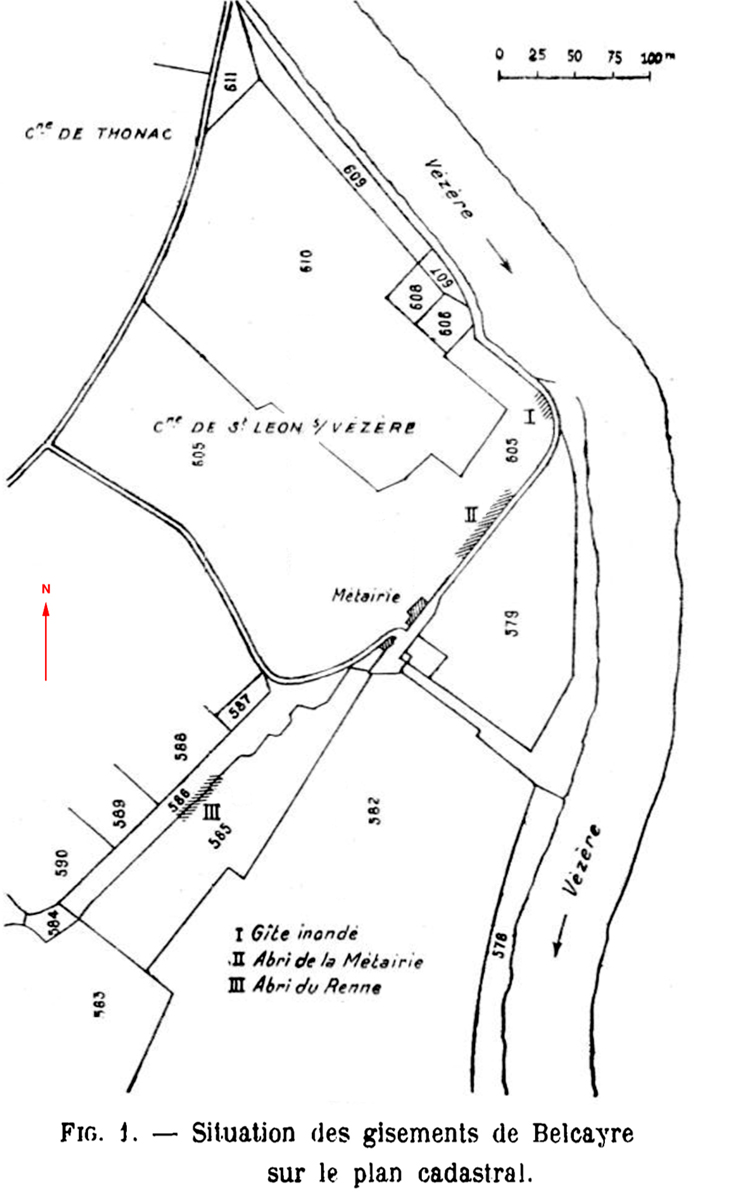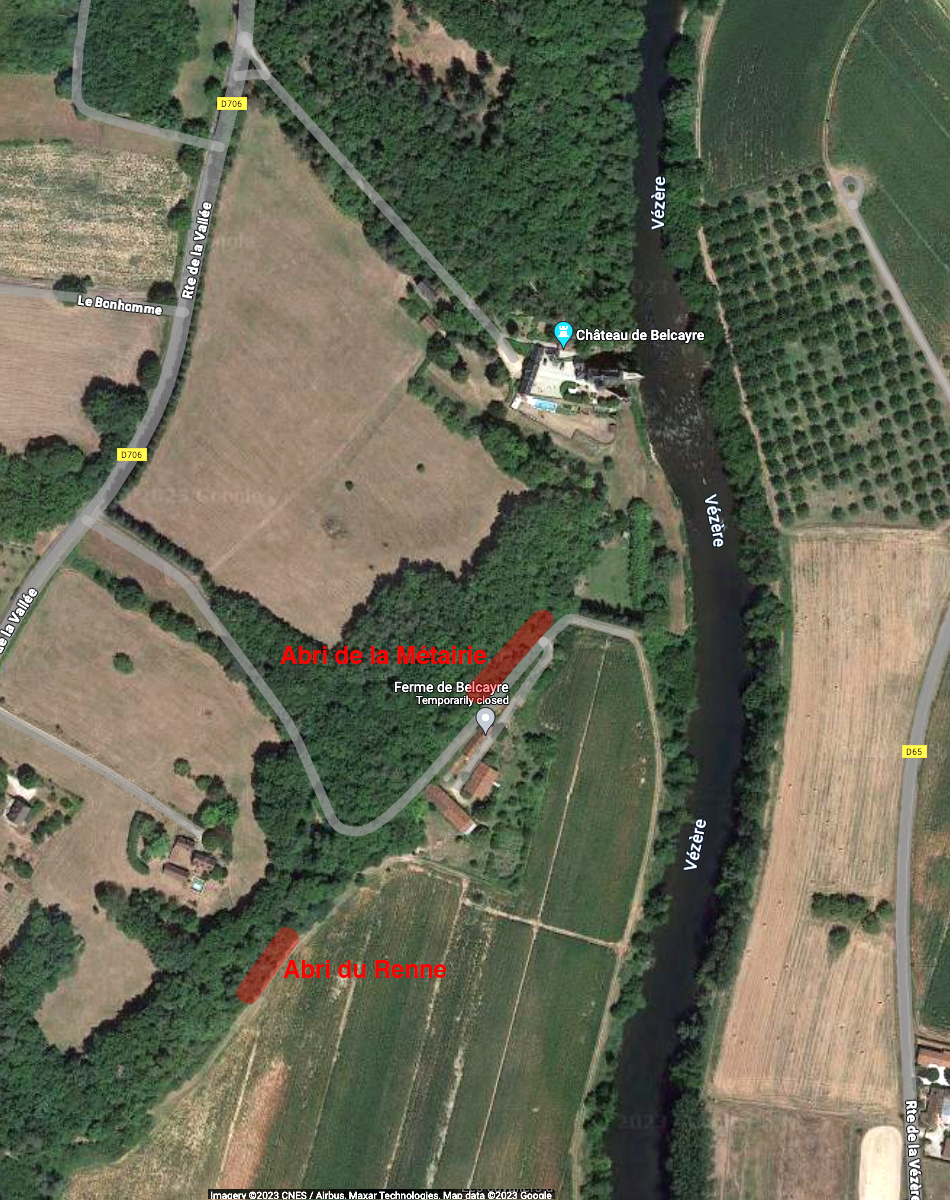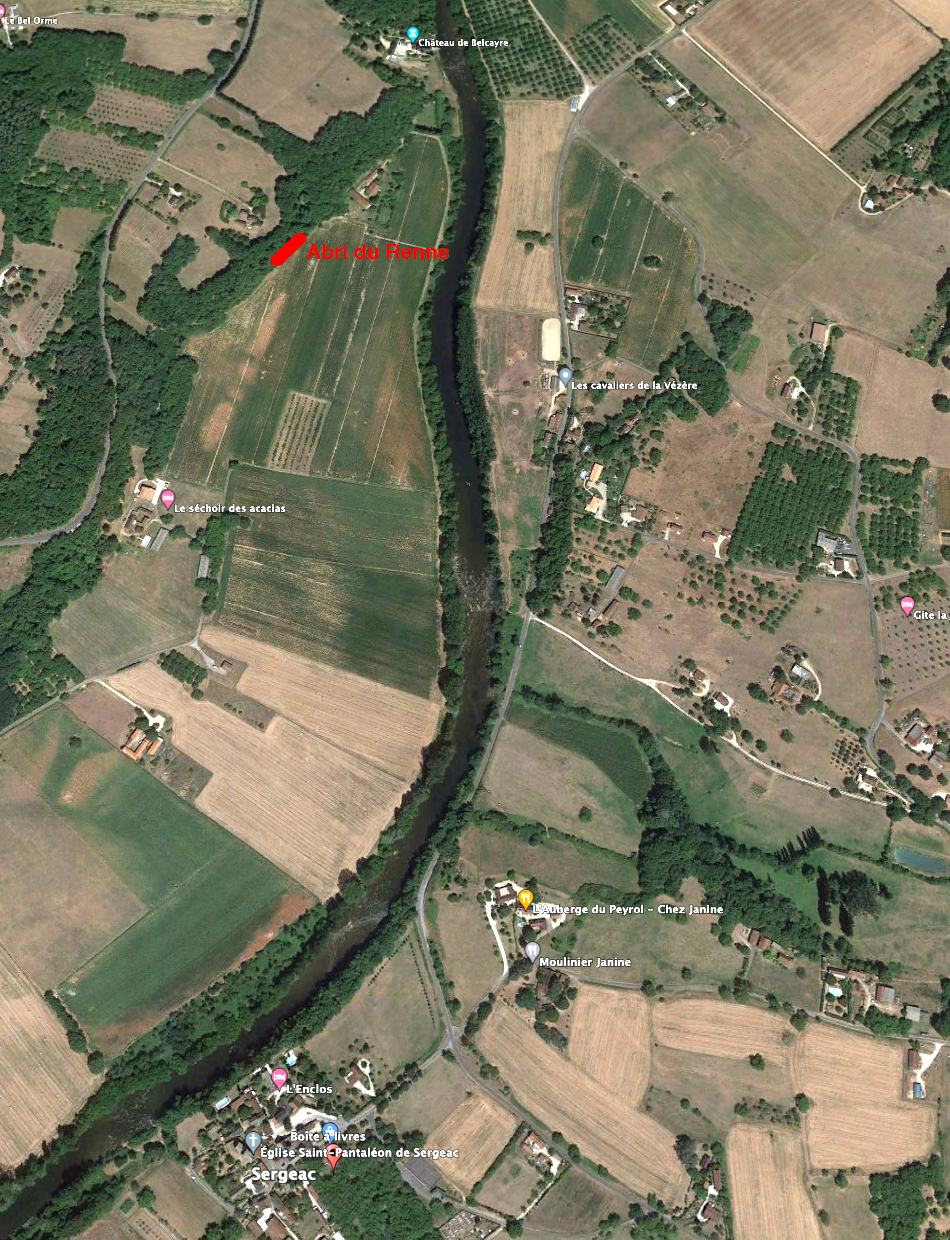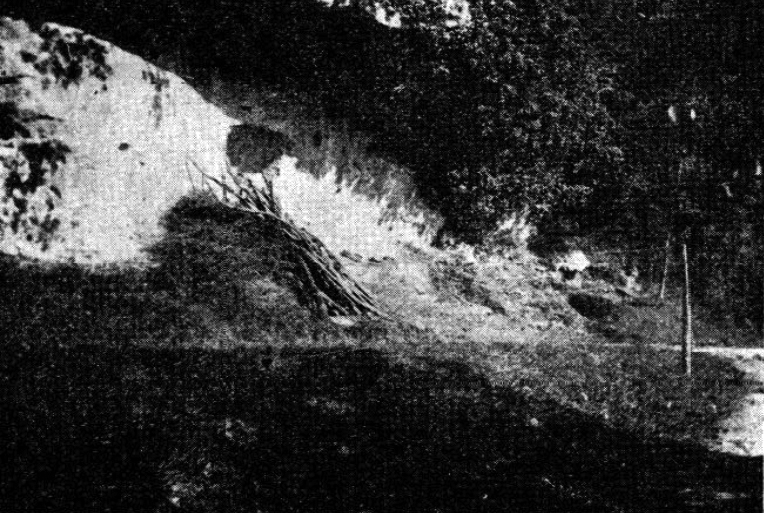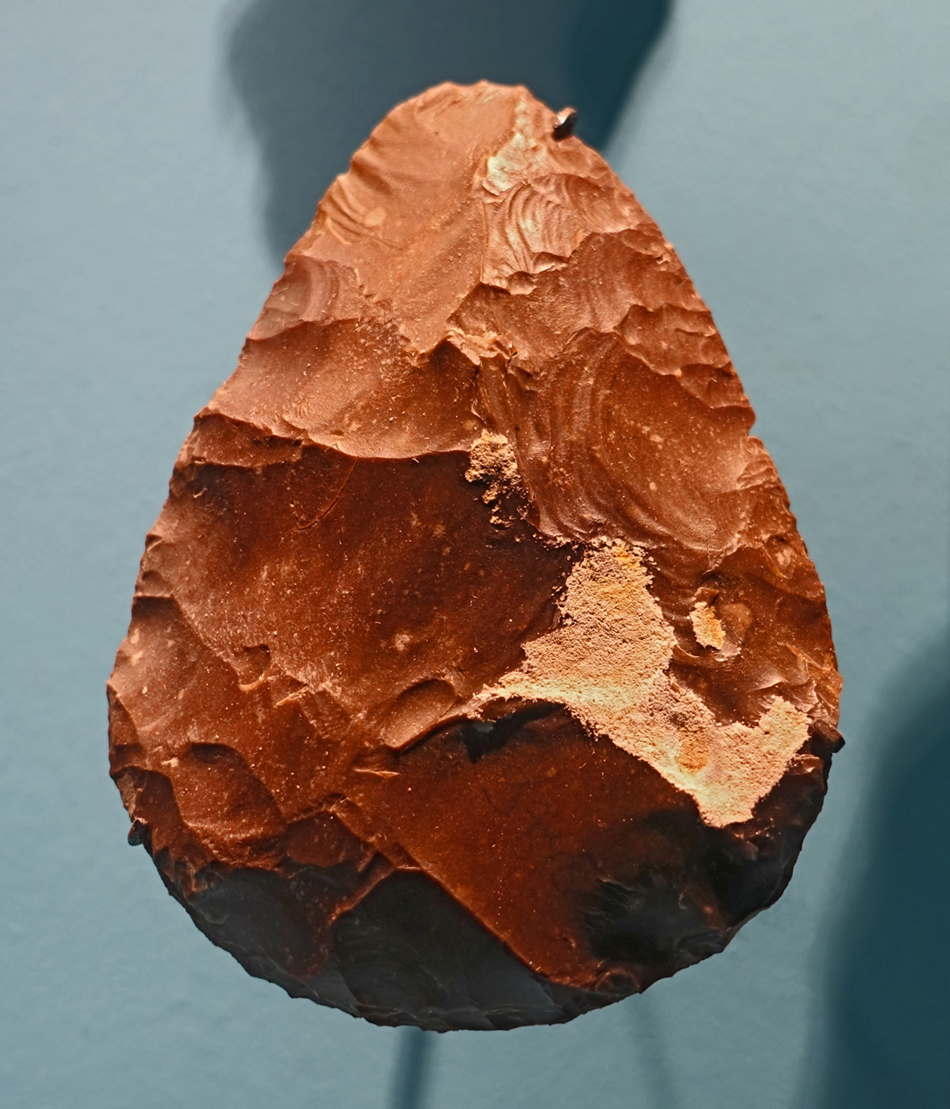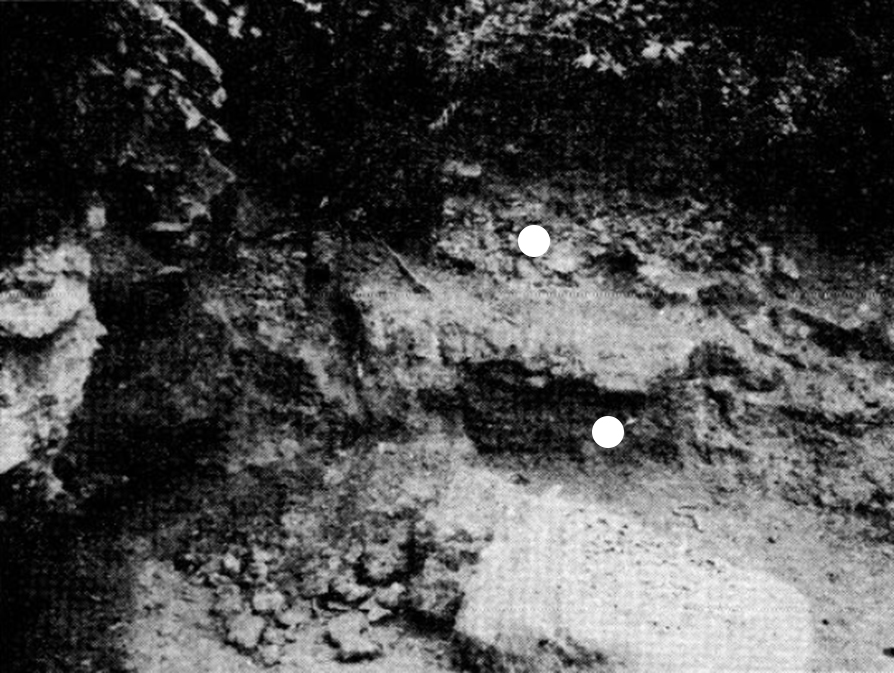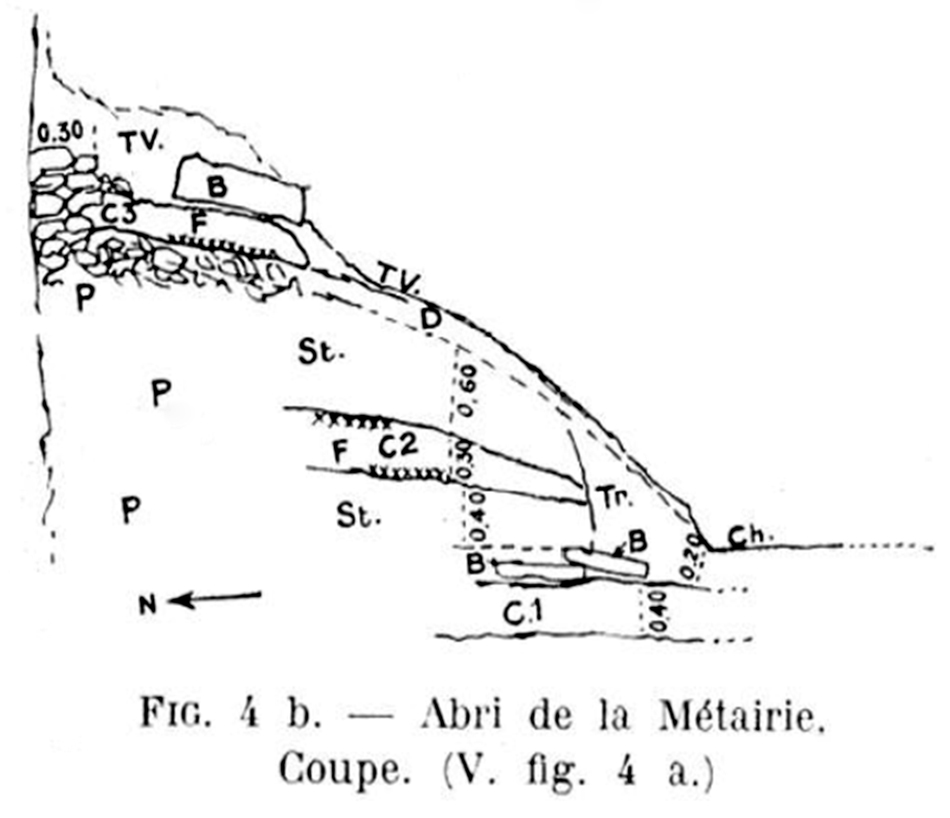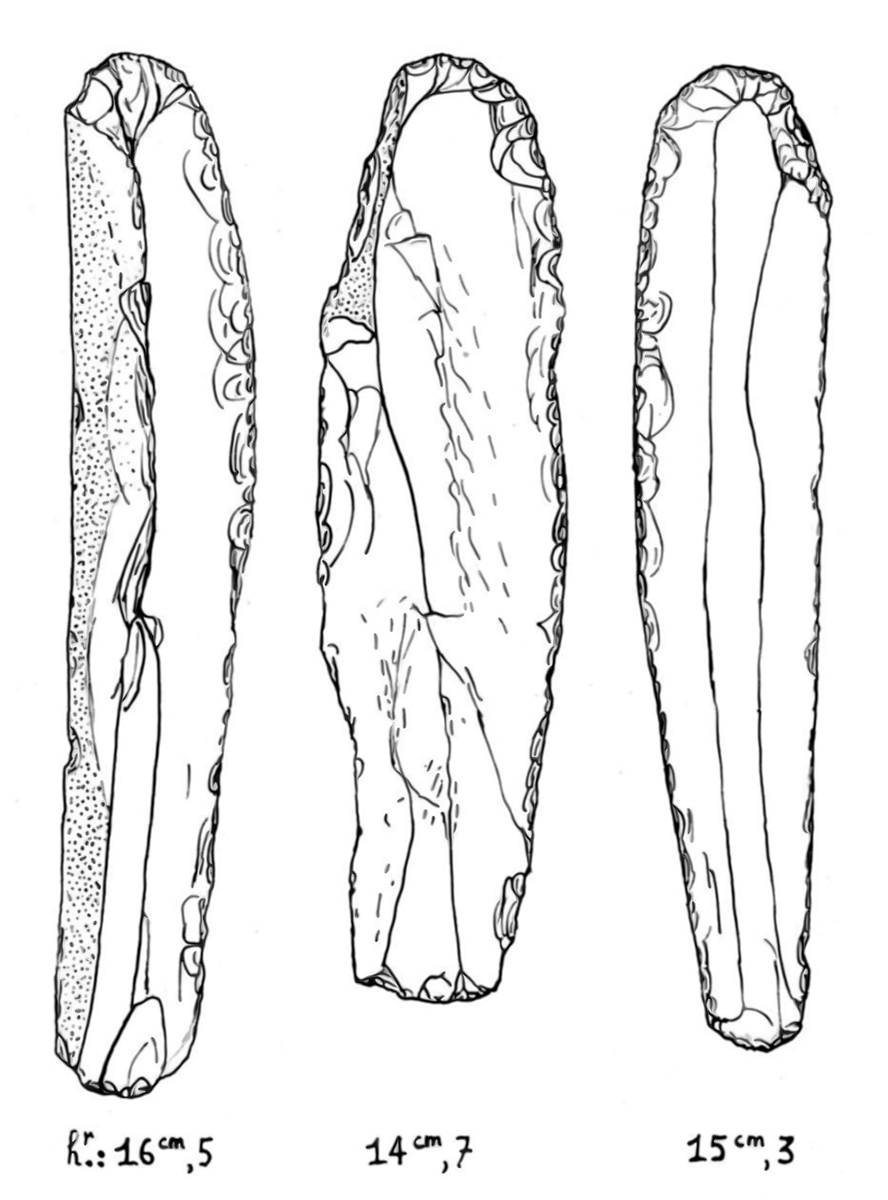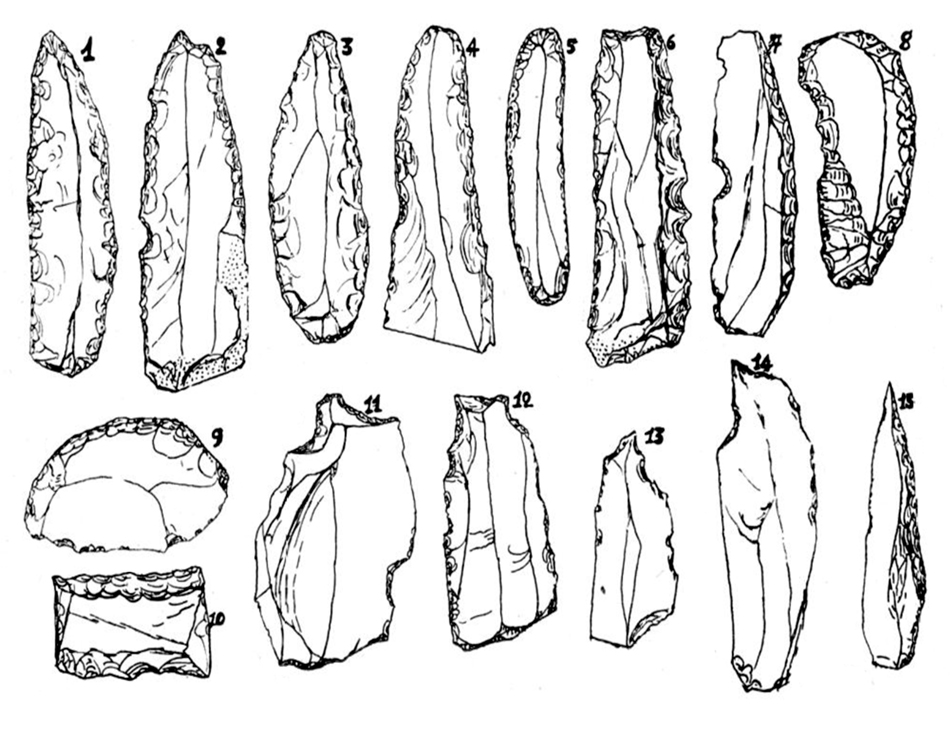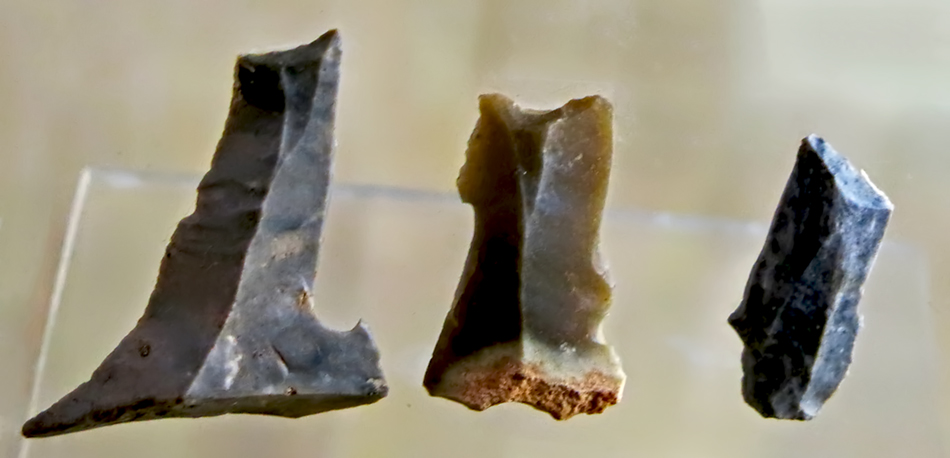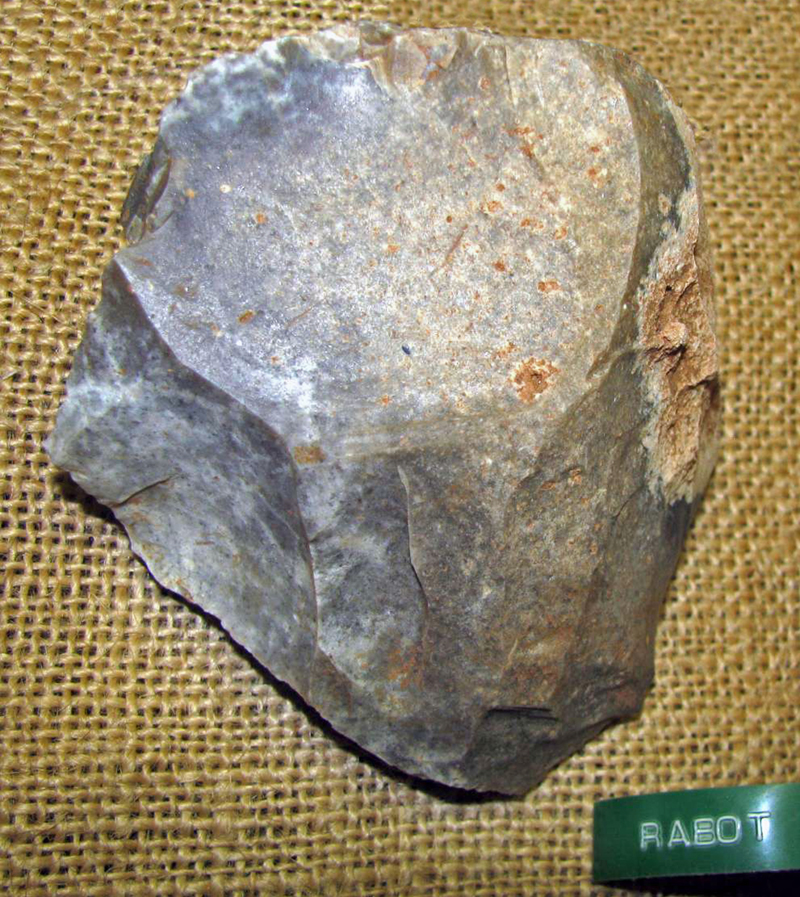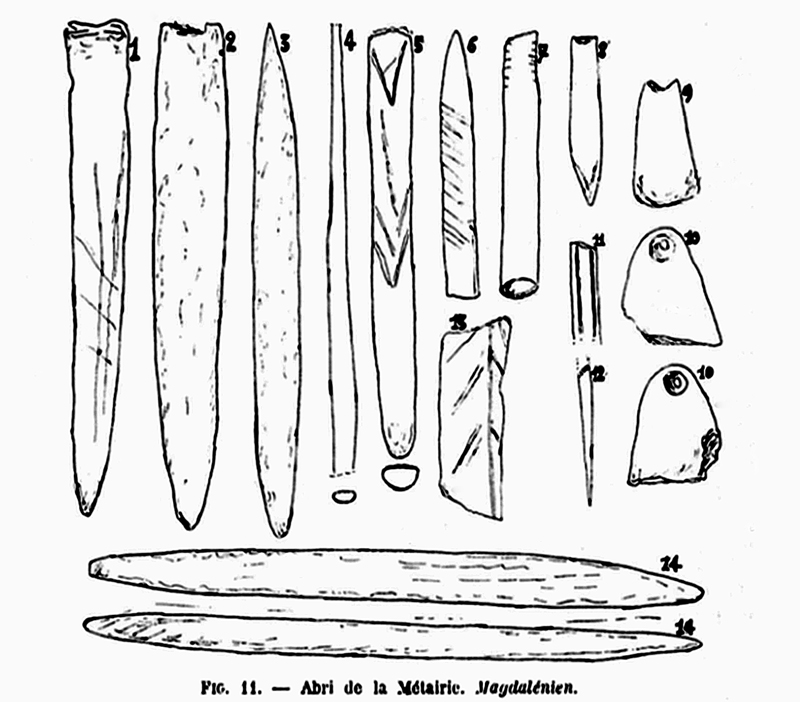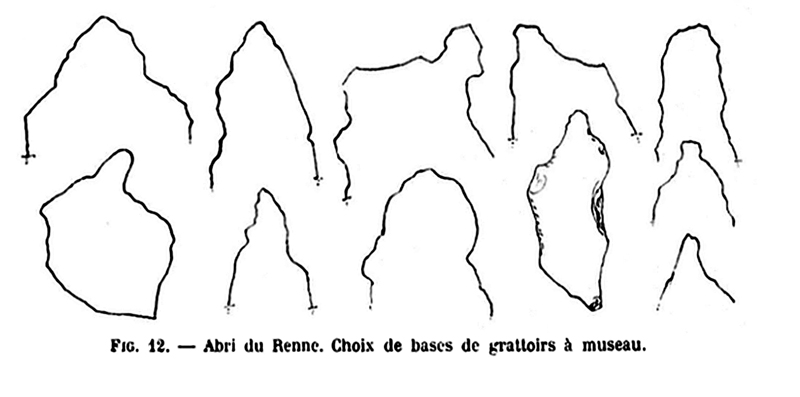Back to Don's Maps
L'abri du Renne de Belcayre (Dordogne)
This abri is on the Vézère river, Commune de Saint-Léon-sur-Vézère.
My sincere thanks to Georges Sauvet for his help in determining the location of this gisement.
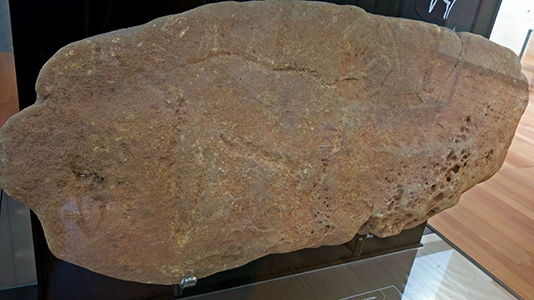
Engraving of an ibex, l'abri du Renne de Belcayre (Dordogne).
Photo: Don Hitchcock 2014
Source: Original, Musée National de Préhistoire, Les Eyzies
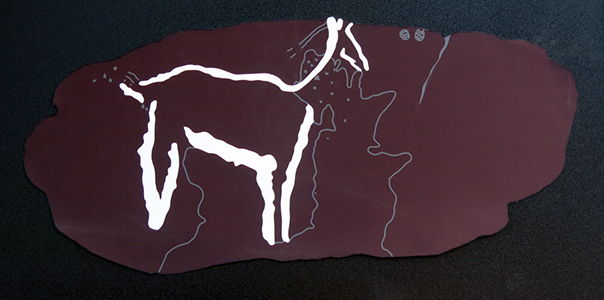
Drawing of the engraving of an ibex above, l'abri du Renne de Belcayre (Dordogne).
Photo: Don Hitchcock 2014
Source: Display, Musée National de Préhistoire, Les Eyzies
With regard to the gisement, Delage (1949) gives this information:
150 metres west of the Belcayre farm, an area of almost entirely fallen rocks provided an abundant deposit, perhaps disturbed on the surface here and there by flint collectors. Having discovered this deposit in 1924, we carried out an extensive survey there, which gave very encouraging results, when the indifference of certain researchers disrupted our work and made it almost useless from a scientific point of view to continue the excavations. However, our first harvest was abundant enough to allow for certain interpretation. The deposit belongs to the Aurignacian, and, it seems, to the middle face of this horizon.
Immediately under the plant layer, there is a large quantity of flakes, nuclei, chipped flints, broken bones, pebbles, etc. Then comes a scree of stones only about fifteen centimetres thick, covering a large slab decorated with an engraved figure. Under these stones, a second layer is also rich in flint of the same types.
We have previously described the engraving, which represents an animal of the deer family, most likely a reindeer (the head being damaged), or rather a female of the reindeer species. The outline of the body was established using a heavy-gauge pick, digging irregular grooves. The style is obviously archaic, schematic with maximum detail. In this silhouette in absolute profile, and of rigid immobility, only two legs are shown: however the air of general truth is quite striking.
The Gisements of Balcayre.
I Gîte inondé - Flooded cottage
II Abri de la Métairie - Abri of the small farm
III Abri du Renne - Abri of the Reindeer
( Note that I have rotated the North arrow and the map itself 90° clockwise to agree with ground truth. I have also rotated and repositioned much of the text on the map to make it more readable after that transformation.
It is fortunate that Delage's map was based on the cadastral map of that time. I was able to find the latest cadastral map of the area, and ascertain that Delage's map needed to be reoriented to agree with ground truth - Don )
Researchers may be interested in the Original map in Delage (1949)
Photo: Delage Franck
Original Source: Delage (1949)
Photo adjustments: Don Hitchcock
Map of the Gisements of Balcayre.
The base map is from Google Earth, a very valuable resource.
Note that the Vézère River has changed its course slightly just north of the gisements, at the Château de Belcayre, compared with the 1949 cadastral map.
The Abri du Renne and the Abri de la Métairie have been marked and labelled in red.
Source: Google Earth, © Google
Additional data: Don Hitchcock
Location map for the Gisements of Balcayre, with the Abri du Renne labelled.
The Abri du Renne is a little over one kilometre north of Sergeac.
Source: Google Earth, © Google
Additional data: Don Hitchcock
Les gisements préhistoriques de Belcayre (Dordogne).
Franck Delage
Five hundred metres downstream from the small town of Thonac, steep cliffs dominate the right bank of the Vézère, in the concave side of a meander where the flow has eaten away the bases of the rocks. A narrow projection carries the small Château de Belcayre which barely allows room for its round tower and its main building, a picturesque evocation of the 15th century. After having bathed the foot of the cliff, the river, pushed in the opposite direction according to the law of the swinging of the concave and convex banks, and moving towards Sergeac, quickly moves away and thus exposes an area of rocks lower down. This area no longer shows a steep cliff, but irregularly spaced sections of rock and brushy scree slopes.
For this entire area, we can indicate the existence of four Palaeolithic deposits, which are spread from upstream to downstream in the following order:
1. at the foot of the rock, almost below the château, a small Magdalenian deposit, the Gîte inondé ( or flooded cottage - Don ), number 605 of the land register. 2. The Abri de la Métairie, a collapsed shelter, which had three superimposed levels: Moustérien, Aurignacian, and Magdalenian.
3. A small abri which was destroyed by a very old quarry and by the establishment of a small path which passes above the farm. ( Not shown on the map - Don )
4. In an area of scree, one hundred and fifty metres further downstream, an Aurignacian deposit. known as the Abri du Renne, number 586 of the land register.
The discovery of prehistoric habitats at Belcayre is due to a researcher often cited in the monographs of the Vézère stations, Alain Reverdit.
( As an administrative clerk for a tobacco company in Montignac, Reverdit was required to visit a large number of allotments growing tobacco every year. This gave him many opportunities to hunt for stone artefacts and he eventually began to excavate sites in the Vezere valley between Condat and Moustier to add to his collection. In 1878 he discovered and excavated a rock shelter named after him, Abri Reverdit, in the Vallon des Roches, now known as Castel Merle. He was one of first and better pioneers working in this region of Aquitaine. After publishing his discoveries he sold his collection to William Allen Sturge - from a biography in the records of the British Museum )
Around 1872-1874, Reverdit collected near the Belcayre rocks a large quantity of flint, but without carrying out any excavations, without putting a pickaxe into the embankments to look for layers.
He noted the presence at Belcayre-Bas as of the remains of a breccia adhering to the rock, at a height of more than one metre compared with the ground level at that time, with flints stuck in this breccia. Continuing his harvests downstream as far as La Rochette, he was convinced that all the deposits 'should form only one and the same station' over a kilometre in length and two to three hundred metres of average width.
He therefore made no effort to differentiate Belcayre from La Rochette. In this set, it essentially signals the Mousterian and the Solutrean: we then ignored the Aurignacian.
The most important parts of Reverdit's collections having passed into the A. Sturge collection, which itself entered the British Museum, we were able to learn from the obliging Curators of the Department of Antiquities that some objects labeled Belcayre-Bas belong to the Solutrean I; They are about twenty leaf-shaped blades, generally rather coarse, except one or two good enough to be called Solutrean. In addition, at the Musée du Périgord, there are, under the label Belcayre-Bas, two fragments of 'laurel leaves' and a section of a shouldered point. We are therefore inclined to accept the existence of the Solutrean at Belcayre-Bas; but it is impossible, at least for the moment, to indicate where this level was placed.
As for us, we have not collected anything relating to it. Moreover, we must not forget that Reverdit — in his own words — had 'collected all the flints in the collection in the middle of cultivated fields... with rare exceptions' 2.
It is even likely that he placed the same label on pieces from both Belcayre and La Rochette.
An excavation which mainly addressed the upper layer of the deposit which we have called Abri de la Métairie was carried out for a few days, around 1900, by Abbot Landesque. This geologist-prehistorian unfortunately left no report, no note concerning this excavation. We only know it through the memories of some people from the neighbourhood.
I. — The Gîte inondé, or the flooded cottage
This residence is located at the bend of the rock along which the narrow path which runs up from the river towards Château de Belcayre. It is about twenty metres from low water. Heavy floods — which are not rare — have frequently reached and drowned this deposit; a plaque attached to the cliff at this location, 2 metres above the path, indicates the great flood of 1876. Along the rock, from the Vézère, the soil is sandy; but, near the bend, a small mound of earth covers the foot of the cliff.
It is in this mound, at the shallow depth of 10 to 15 cm, that M. Borias collected, around 1921-1922, a certain number of flints, which, far from appearing in situ, seemed rather to have been deposited there by the movement of water. It can be assumed that there was a small deposit a very short distance upstream, along the rock, that this deposit was destroyed by the floods, and that remnants were carried by the water to the point at which they were found. The space they occupied did not exceed 170 cm long by 100 cm wide.
The flints collected are scrapers, burins and blades, which seemed Magdalenian to us; there were also two fragments of reindeer antler bearing traces of work. We also noticed hearth stones and a few pebbles that may have been used.
II. — L'abri de la Metairie
Fig. 2
Abri de la Métairie
At the foot of the cliff is a small dirt path passing from right to left. The deposit is at the right end of the abri. We can see the overhang of the shelter at the top.
Photo: Delage (1949)
150 metres downstream from the flooded cottage, near the crossroads formed by a path by which one descends from the plateau to the farm, and by another path running upstream along the foot of the rocks, one sees the remains of a cliff, about ten metres long, the base of which is partly bare. This section of cliff forms a shallow abri; it is now very degraded, and no longer presents any overhang. It is somewhat fragmented and most of it is hidden under an embankment of scree and earth.
At the foot of the embankment, the small path is two metres above meadows which represent the average level of the valley (Fig. 2). There are no fluvial sediments, but only contributions by runoff from the top of the upper plateau. The path, which was built around 1885, also covers the bottom of the embankment, and therefore the lower part of the deposit, which would have gone as far as the meadow. The platform of this path was very likely established, at least in part, with earth and stones taken from the deposit, and rather from the top of the deposit, that is to say where we discovered Aurignacian and Magdalenian layers; it is very likely that the road workers did not touch the deepest layers.
In this part of the deposit (in the north-south direction), to know the full extent of the archaeological layers, it would have been necessary to break up the path - which was impossible. We were able to study three archaeological levels in this deposit which we will describe starting from the bottom.
A) Mousterian level
Fig. 3
Abri de la Métairie
Blocks fallen on the Mousterian layer.
Photo: Delage (1949)
This level was excavated by us between the path and the bare base of the cliff, at the crossroads indicated above. The rear part came up against the rock. We previously described the Mousterian of Belcayre, by studying the cores in detail; knives (couteau à dos, often with semi-flattened backs so that they may be used in the hand), triangular flakes, saws, burins, scrapers, nosed pieces, notched pieces, multi-purpose pieces, quadrangular flakes, etc.
We will not return to these morphological remarks, and we will limit ourselves here to describing the essentials and the conclusions: first, a certain tendency to create scrapers with an arched head, carinated scrapers, and burins. Then, the frequency of the abrupt retouching, very different from standard Mousterian retouching; and finally the presence of a coup de poing, a heart shaped handaxe.
Mousterian heart shaped handaxe, or biface, in flint, from Saint-Amand-les-Eaux, France, circa 49 200 BP.
( This is a superb piece of work, worthy of pride of place in any art gallery in the world, yet such masterpieces were produced in their millions. Sometimes when I am putting up these photographs, I am struck by the love of symmetry and beauty in all humans.
We make things better and more perfect than they need to be, just because of the way we are. We take far more time and effort and skill to create useful things than they logically require. We take pride in our work, and make things as well as we are capable of, whether the object requires such accuracy and care or not.
A simple chopper, made in a minute or two from a pebble in a stream bed, would have performed most of the tasks demanded of this beautiful tool.
The creator of this handaxe died nearly fifty thousand years ago, but this artefact they left behind gives us a small though imperfect window through which to see the things that were important to them in their daily lives, and their pride in good workmanship for its own sake - Don )
Photo: Don Hitchcock 2018
Source and text: Musée de l'Homme, Paris
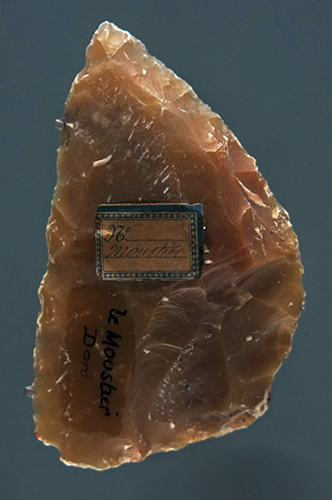
Racloir, side scraper, emblematic of the Mousterian.
This particular racloir has both an arched and a straight working surface.
Photo: Don Hitchcock 2015
Collection: É. Cartailhac
Source: Original, Muséum de Toulouse
This layer, which was included, looking as if sealed between two screes formed of blocks and slabs originating from the collapse of the cornice of the shelter, was clearly isolated from the rest of the deposit (fig. 3): there was no other layer above, because of the clearing of the foot of the cliff, nor below, as a survey proved to us; therefore there was no local reference point. But the comparison of our harvest with what other Mousterian deposits in Périgord yielded allowed us to conclude as follows: the Mousterian of Belcayre is similar to the Mousterian of the Acheulean tradition, and rather responds to the last phase of this tradition; it belongs to the final Mousterian and seems to represent the preludes of the first Aurignacian industry.
To the objects published in 1927, we add here a slight supplement: pieces with transverse endings forming a burin created by symmetrical retouches on the right and left, strangling (waisting) the piece; thin flakes with more or less retouched edges, including one which looks like a fléchette. ( fléchettes are leaf-shaped points characterised by short, semi-abrupt retouch, sometimes inverse, at one or both extremities of the blade blank, extending sometimes along one or both margins - Don )
There were also prototypes of thin flake scrapers, with retouching, serrations and symmetrical flaking, a drill/point, the right edge quite heavily retouched, checkmark in below — a multi-purpose piece, scraper-tip-notch, a drill point, the right side strongly retouched, left side very scuffed, but the point well defined, a small-nosed point, and some carinated prototypes.
B) Aurignacian level.
The rest of the deposit had the following appearance:
1. opposite the better preserved part of the cliff, touching the crossroads of the two rural roads, and a little below the sloping ground rock, a Mousterian layer, with no other archaeological level above it. We can assume that this was not the case in the past and that there was clearing of an upper level when a dwelling was built (Gallo-Roman period? early Middle Ages?) with beams supported in holes dug in the cliff. We can also assume that landslides from the overhang of the shelter forced the Mousterians to abandon the place.
2. To the right of this zone, in a space 5 metres long, an Aurignacian level which butts against the upper part of scree located barely higher than the blocks which cover the Mousterian.
On this layer, a very clear Magdalenian level completes the deposit.
Abri de la Métairie. Position of the Magdalenian above the Aurignacian.
The two marks (white circles) indicate layers C2 (Aur.) and C3 (Magd) of the coupe (Fig 4b below)
Legend:
TV - Terre Végétale → topsoil.
TR - Terre remuée → disturbed soil.
D - Déblais et relicta antérieurs → previous excavations and discards.
Ch - Chemin latéral aux rochers → side path to the rocks.
P - Pierrrailles et blocs → stones and blocks
St. - Zone stérile → sterile zone
B - Blocs → blocks
C1 - Couche moustérienne → Mousterian bed
C2 - Couche aurignacienne → Aurignacian bed
C3 - Couche magdalénienne → Magdalanian bed
F - Foyer → hearth
The coupe (cross section) of this second zone, through a trench perpendicular to the rock, presents from top to bottom (fig. 4 a and b):
a) small scree: 10 cm
b) scree with stronger elements, blocks: 30 cm;
c) Magdalenian layer: 20 cm;
d) intermediate scree: 25 cm;
e) upper part of the Aurignacian layer: 15 cm;
f) intermediate scree: 20 cm;
g) Aurignacian layer: 30 cm.
( Note that the defining layers a to g described above do not appear on the diagram Fig. 4 b - Don )
Excavated soil, which is claimed to come from Father Landesque's research, covered part of the deposit. We found there some interesting discards; for example, a very good scraper/burin, a fragment of reindeer antler with an oval ending, probably the end of a smoother, a small block of limestone with three small cupules, another stone with a cupule, a sandstone disc (probably from the Brive region), elliptical in shape, having visibly been used to grind and to grind smooth (the two extreme faces are a little crushed, chewed, and the two lateral faces are smoothed), a half of a godet, a receptacle, having been part of an ochre palette. These objects appear to us to have belonged to the Magdalenian layer, in comparison with the Abri Reverdit, at the Castel Merle / Vallon des Roches of Sergeae K. Note also that the excavations gave mainly reindeer teeth, while the Aurignacian layer provided mainly horse teeth.
The Aurignacian horizon included three hearths, which were not at the same height due to the presence of several blocks, which must have come from the pediment of the shelter, probably having fallen towards the end of the Mousterian period. These stones were embedded in the archaeological layer. The overall colour of the layer was reddish.

Fig. 6 - Abri de la Métairie, Aurignacian.
1: Fragments of a 'split base'.
2: Spear head bevel.
3: Projectile point.
4, 5, 6, 7: Awls.
a) Bone tools (reindeer bones and antlers) (Fig. 6). — The characteristic object is the point with a split base, represented by five fragments of a very clean appearance, the main one of which indicates the diamond type. We can clearly see the work of the flint which has split the base, and the thinning by scraping of the two faces. This confirms what has been observed elsewhere for the manufacture of this type of object.
Fragments of reindeer antler also demonstrate the manufacture of spear heads: sawing from above and below, removal of material to prepare the sub-cylindrical shape, and sawing across to detach the object. An oval spear head base has one smooth side, and the other remains rough. A fragment of an assegai shows a clearly cylindrical point.
An oval spear head base has one smooth side, and the other remains rough referred to above may be a spear head with a single bevel as shown here, from Laugerie Basse. The rough surface of the bevel allows the spear head to be attached securely to the shaft with birch bark tar and bound with sinew.
Photo: Don Hitchcock 2014
Source: Original, Musée d'Archeologie Nationale et Domaine, St-Germain-en-Laye
Several awls were found, either whole or fragmented, some of which are made from a finely worked bone splinter. Noteworthy is an arched awl, and a double pointed awl.
In total, the bone tools were few, and generally fragmented (because of falls of blocks on the hearths). But they are defined enough to indicate the typical Aurignacian type.
b) Lithic tools. — A fairly large number of pieces are made from coloured flint with a very pretty appearance: blue-black, translucent yellow, greenish spotted jasper, purplish red, speckled white, light honey, dark wax, red jasper, smoked chalcedony, pink chalcedony, jasper-agate with ribbons or zones, etc. We have noted in other deposits the predilection of the Aurignacians for these colours which attract the eye. We have previously noted this taste for varied and even variegated shades in our finds from the Belcayre-Haut plateau.
The blades are particularly interesting; debitage from blades is one of the characteristics of this level. The length quite often exceeds 10 cm, and may even go up to 15 and 16 cm: The widest are 40 and 45 mm. They are frequently thin. Most are flat, but with several arched. In many cases the retouch is excellent, affecting the entire perimeter, with variable intensity, sometimes very short and light, sometimes long (a throwback to the mousterian), here very thin, there thicker. The opposite end at the heel is usually oval. The blades provided good knives and delicate penknives. There are other knives made from a thin flake, the back of which has been retouched and even flattened. Few blades appear to have been cut with a view to constituting points of spears or darts; this type of use was preferably made with reindeer antler. However, the top of the level gave us a La Gravette point, rather massive, with a strongly depressed back and a sharp end. Flattened bladelets were very few in number; the cutting side shows signs of use.
Fig. 7 - Abri de la Métairie, Aurignacian, large scrapers.
Belcayre also shows debitage from very good scrapers, the length of which is up to 16 cm, thin, and with the perimeter retouched, and the heel finished off (fig. 7). Large shapes are rather rare. A few scrapers have a notch, either on one side of the head or on one of the long edges. Several have one edge retouched, and the other chipped like a used knife. The morphological details are so numerous that it is impossible to report on here. Note, however, that some blades have been turned into concave scrapers, some are rectilinear and a few are 'fan-shaped'.
Double scrapers, with a scraper formed at each end, were not numerous; they are retouched or chipped all around. The shapes approaching the circular type were also small in number.
Fig. 8 - Abri de la Métairie, Aurignacian.
1, 2, 3, 4, 5: Retouched blades.
6, 7, 8, 9: Knives and saws.
10: Truncated, retouched blade.
11: Nosed scraper
12, 13, 14: Various burins.
15: Sharp spear point, of the Gravette type.
Regarding lamellar tools (fig. 8), it is necessary to note truncated blades, in the shape of a rectangular parallelogram, among which we notice a desired accommodation on the truncation, and retouching or use on one or two edges.
Nosed scrapers, more often on flakes than on blades, were numerous; the forms are very varied; in many the muzzle is very well exposed; sometimes it becomes refined to become a sort of beak. Quite often it forms the end of a carinated part. The carinated scrapers are also a remarkable aspect of the deposit, very varied in width, height, and carination. There are several very good specimens, whose dome or pyramid shape is very successful.
There are many varieties of burins: dihedral burins, multi-sided burins, burins with retouched sides, etc. Burins on the angle of blades are numerous and interesting; we note one, because of its size, which is 10 cm long by 4 cm wide. we will talk about this further. The reindeer antler artefacts were almost all broken.
Nosed scrapers, more often on flakes than on blades, were numerous; the forms are very varied; in many the muzzle is very well exposed; sometimes it becomes refined to become a sort of beak. Quite often it forms the end of a carination.
The carinated scrapers are also a remarkable aspect of the deposit, very varied in width, height, workmanship; there are several very good specimens, whose dome or pyramid shape is very successful.
There are many varieties of burins: dihedral burins ( see image below - Don ), multi-sided burins, retouched-sided burins, etc. Burins on the angle of blades are numerous and interesting; we note one, because of its size, which is 10 cm. 5 long by 4 cm. wide.
The small 'Noailles burins' ( see image below - Don ) were few in number.
There are enough pointed chisels in quantity to constitute an important feature of this level. Some drills of normal quality, on blade ends, or on flakes; a few are strong enough to be considered taps (fig. 9 and 10).

Dihedral Burin.
A dihedral burin is made by two (or more) intersecting burin facets, often on a blade, which create a chisel suitable for engraving.
Photo: Don Hitchcock 2014
Source: Display at Abri Pataud Museum, apparently original.
The Noailles burin is a very small burin with multiple bevels. It is a flake tool retouched to give several chisel-like edges. It owes its name to the Grotte de Noailles in the commune of Brive-la-Gaillarde, Corrèze, in southwestern France.
The Noailles burin is characteristic of the Gravettian, circa 28 000 BP - 23 000 BP. These tools have been retouched to give several chisel like edges and a blunt, grippable rear edge.
Photo: Don Hitchcock 2014
Source: Display at Abri Pataud Museum, apparently original.
Additional text: Wikipedia
Triangular flakes have various uses (points, knives, etc.), some are retouched in order to make them look better than makeshift tools. The knives, the saws, the burins are nothing special. Numerous scrapers, of all sizes; edge either rectilinear or convex; notches (some of which are large), quite frequent on the sides of scrapers, natural or retouched backs; two amygdaloid forms; some sharp quartz knives.
Several pics (8 to 9 cm long), generally globose, with prepared tip, or, at least, flaked by use; they are tools of sculptors or makers of rings and cupules. We found some in the discards of previous excavators.
Numbers for the main pieces of the lithic industry:
Scrapers 90 (including 31 on blades, 17 on flakes, 5 rounded, 9 double, 16 carinated, 12 with a muzzle or nose)
Burins 75 (including 39 ordinary types, 10 busqué (parrot's beak) burins, 26 burins on angles)

Burin busqué - the Beaked Burin
Three or more fairly regular spalls, often removed from a Spall Removal Surface (SRS) of dihedral type, approximate a semicircle. An edge of this shape is sometimes described as the "gouge" or "busqué" type.
(This is an excellent diagram of what I think of as a "classic" beaked burin, as described by Burkitt (1925) above. Note the front vertical spall, and the notch taken out of the rear of the burin to make sharpening easier, so that a spall comes off easily when retouching. - Don)
Photo and text: Movius et al (1968)
Burin on an angle.
Tipping a burin can be done in two ways. In the first, the blade is rested on an anvil stone and struck with a wood or bone baton, causing the tip to fly off at an angle determined by how the blade is held. In the second method, the blade is pressed sharply against a stone to remove the tip. If a double bevel is desired, the blade is turned over and flaked again.
Photo and text: Howell (1965), drawings by Lowell Hess.
Burins on one end, scrapers on the other 4.
Scrapers 36
Rabots 13 - Rabots are heavy 'push-plane' scrapers made on blocks or thick flakes, abruptly retouched.
Mousterian Rabot from Le Ruth, in the display of the little museum run by the owner of the site, at Sous le Ruth.
Rabots are heavy 'push-plane' scrapers made on blocks or thick flakes, abruptly retouched.
Photo: Don Hitchcock 2008
Source: Musée du Ruth, Sous le Ruth
Retouched blades 27
Backed blades (lamelles rabattues) 27
Knives 27
saws 17
Awls 5
Pics 4 (used to peck cupules or petroglyphs or engraved lines in stone)
Triangular pieces 12
Quadrangular pieces 9.
c) Adornment. — A little manganese and some ochre represent the colouring materials; no decorative motifs were discovered; — a shell pierced with an irregular hole; two pierced teeth (a fox canine; an incisor of horse).
C) Early Magdalenian level.
In the upper part of the deposit, Magdalenian hearths butted up against the cliff; the forward extent was very limited, the slope of the embankment leaving only a small horizontal space; moreover, the anterior part had been removed by various researchers.
The upstream side, the only one respected, provided a good number of interesting pieces, despite its limited space. The layer, 10 to 25 cm thick, was crushed at several points by blocks,notably the large 'pierre anneau' block which we will talk about later. The reindeer antler objects were almost all broken.
Pics 4 (used to peck cupules or petroglyphs or engraved lines in stone)
Triangular pieces 12
Quadrangular pieces 9.
c) Adornment. — A little manganese and some ochre represent the colouring materials; no decorative motifs were discovered; — a shell pierced with an irregular hole; two pierced teeth (a fox canine; an incisor of horse).
C) Early Magdalenian level.
In the upper part of the deposit, Magdalenian hearths butted up against the cliff; the forward extent was very limited, the slope of the embankment leaving only a small horizontal space; moreover, the anterior part had been removed by various researchers.
The upstream side, the only one untouched, provided a good number of interesting pieces, despite its limited space. The layer, 10 to 25 cm thick, was crushed at several points by blocks, notably the large 'pierre anneau' block which we will talk about later. The reindeer antler objects were almost all broken.
The fauna is clearly dominated by reindeer (teeth, hooves, and antlers are abundant). It also contains small rodents. birds, fish, without any remarkable particularity. We have indicated the predominance of horse remains in the underlying horizon.
With regard to flint tools, there is an absence of La Gravette points, of notched points, and of laurel leaf points. With regard to bone and reindeer antler tools, there are no split bases and no harpoons.
The level studied here therefore appears as belonging to the early Magdalenian, with the impression of a certain continuity with the Aurignacian as far as flint is concerned. The presence of Pierres à Anneaux and cupules recall both the Aurignacian of Sergeac ( at Abri Blanchard, also known as Abri Didon, since the first excavations in Abri Blanchard were carried out by Marcel Castanet and Louis Didon between 1910 and 1912 - Don ), as well as the abri Fongal, and the Early Magdalenian from the Reverdit shelter (Castel-Merle - Vallon des Roches). When discussing the beginning of the Magdalenian, we believe it useful to point out particularities with more details than for the Aurignacian level, but instead for bone tools rather than for lithic tools.
a) Lithic tools
Flint flakes used:
Small pyramidal or carinated nuclei which can be used as planes (there was a small double plane, length 45 mm, height 35mm).
Atypical flakes used in various ways, including a long flake measuring 125 mm, with a well-shaped heel, and with strong traces of use at the oblique end.
Blades, thin, flat, more or less used.
Retouched blades, one of which has a narrowing tending to a peduncle.
Pointed blades (including one retouched slightly on the right, plus one strongly on the left).
Burins of various types, including several with retouching.
Drills and awls, of correct types, without particular success; note a strong perception well cleared by two symmetrical notches. Scrapers: rarely on blades (one example of an extremely thin blade); scrapers on flakes, some of which are concave; a roundish flake (dimensions 40 mm x 32 mm). Scrapers with a beak or snout, of small dimensions (50 mm to 70 mm long), sometimes with a keeled profile. Rabots, sloppily manufactured.
Microliths: numerous bladelets with flattened, blunted backs, visibly worn, sometimes having a tip shaped into a point; one fragment is like a survival from La Gravette with a strongly retouched back and a strong acute point. Small burins (19 mm to 24 mm long).
Account of the main parts of the lithic industry:
Scrapers/grattoirs 34 (including 9 on blades, 15 on flakes, 1 round, 1 double, 5 carinated, 3 with snout)
Burins 31 (21 ordinary, 6 on angles, 4 with retouched sides).
Burin-scraper 1.
Scrapers/racloirs (side scrapers) 13: rabots 10, cores cut into a pyramid for use as rabots 3; Retouched blades: backed blades 14, knives 16, saws 6, drills 4, made of quartz 4.
b) (Figure 11): tools made from reindeer antler or bone.
The work of sawing and cutting these materials is shown by very numerous fragments. Thus, for the manufacture of sticks (baguettes), we see how a piece of wood was sawn with two longitudinal cuts pushed to a depth of 5 to 8 mm, after which the baguette was detached, which had 3 smooth sides and one rough side which was flattened. Elsewhere we see grooves from which the material for needles and awls was extracted.
( Note that for needles, awls, and spear heads, bone and ivory are by far the better materials for that purpose than wood. I am unsure what the sticks or baguettes of wood with sides of 5 mm to 8 mm were used for.
Long lengths of wood of around two metres in length were taken from suitable small saplings and prepared for use as spear shafts (darts) thrown by atlatls. Darts resemble large arrows or thin spears and are typically from 120 cm to 270 cm in length and 9 to 16 mm in diameter.
Hand thrown spears were in general much the same length, but heavier because of their larger diameter. The hand thrown Schöningen spears, from more than 300 000 BP were 184 cm to 253 cm long, with diameters ranging from 29 to 47 mm.- Don )
Needles generally had a very fine, very sharp point, and were flat or
cylindrical (found in fragments).
Small awls, either in bone (one of which is clearly smoothed and polished), or in reindeer antler (some of which show traces of sawing and faceting of the rod had before being made cylindrical).
(Pointe de trait) - Projectile point : this type of object has several types, of which the semi-cylindrical type ![]() is the most common; but there are also cylindrical
is the most common; but there are also cylindrical
![]() or slightly sub-cylindrical
or slightly sub-cylindrical ![]() shapes. The tips are not very sharp; a piece 13 cm long. is blunted, one piece, slightly arched (length 11 cm), shows at its tip that the end has been cut across diagonally a large piece (length 130 cm) has an unfinished, blunt end.
shapes. The tips are not very sharp; a piece 13 cm long. is blunted, one piece, slightly arched (length 11 cm), shows at its tip that the end has been cut across diagonally a large piece (length 130 cm) has an unfinished, blunt end.
In some other cases, the tip is finely thinned and pointed: such as a long spear (length 165 cm), remarkable for its small thickness (maximum 11 mm ).
Among the bases: a conical base on a 165 cm spear; a 50 mm long bevel on a 110 mm long piece. — a double bevel, with smooth sides, 42 mm long for a piece 130 mm long.
A bone dagger, 125 mm long, with a handle made of an adapted epiphysis, with a thick shaft, and solid tip; rods (in fragments) with a cross section either rectangular or subcylindrical.
Smoothers and spatulas, including a fragment with an oval end, with one slightly convex side, the other slightly concave; — a piece of bone (very damaged) of flat and thin shape (like a paper knife) with an oval tip and rounded sides.
Wedges and chisels, including a fragment of a large tool with a cylindrical shaft (average diameter 17mm), the end of which, with a flat bottom and convex top, ends in a blunt oval.
Ornamentation:
A series of 15 small oblique, parallel lines on the back of an awl; 6 small notches on the lower part of a half-round spear; on the broadest face of the dagger, long parallel lines, intersected by small oblique lines; — on the flat face of the arched spear, a groove 25 mm long, and, on the back, a series of unequal chevrons, connected by a line drawn along the axis of the piece.
This ornamentation, simple and uniquely linear, responds well to what we know about the ancient Magdalenian.
c) Adornment. Ochres and manganese common; a pebble that served as a palette for red ochre; gray sandstone knobs, elliptical in shape, the flat faces of which are worn; — a small flat pebble, perforated for suspension, in good condition, and another small pebble with a broken hole.
d) Pierres à anneaux and cupules
At the end of the layer lay a very large block (dimensions: 1700 mm x 1400 mm) which crushed the layer.
When excavated and turned over, this block showed interesting features, which we describe going from left to right:
1. Oval cupule (60 mm x 40 mm, depth 14 mm), with a red spot next to it.
2. Large anneau on the edge of the block, 35mm wide, 45 mm thick.
3. below, a large oval cupule (180 mm x 120 mm), small depth (6 mm)
4. small broken anneau.
5.the near the edge, rough outline of an unfinished anneau
6. an unfinished anneau blank.
7. an unfinished anneau, more advanced.
8. an unfinished anneau barely started.
9. A small broken anneau, on the broad face of the block.
In addition to this large block riddled with traces of man's work, we found in the rubble a small stone hollowed out with a well-shaped cupule, and another stone, of small volume, where three small cupules can be seen. Let us recall the existence of rings and cupules in the old Magdalenian of the Reverdit shelter (Roches de Sergeac) which we have published and represented by photos (see above, p. 9, n. 1.).
III. — L'ABRI DU RENNE
150 metres west of the Belcayre farm, an area of almost entirely fallen rocks provided an abundant deposit, perhaps disturbed on the surface here and there by flint collectors.
Having discovered this deposit in 1924, we had carried out an extensive survey there, which gave very encouraging results, when the indiscretion of certain researchers disrupted our work and made it almost useless from a scientific point of view to continue the excavations.
However, our first harvest was abundant enough to allow a certain interpretation. The deposit belongs to the Aurignacian, and, it seems, to the middle part of this era.
Immediately under the topsoil, there is a large quantity of flakes, nuclei, worked flint, broken bones, pebbles, etc. Then comes a scree of stones only about 150 mm in thickness, covering a large slab decorated with an engraved figure.
Under these stones, a second layer is also rich in flint of the same types. We have previously described the engraving, which represents an animal of the deer family, most probably a reindeer (the head being damaged), or rather a female of the reindeer species (fig. 5).
The outline of the body was established using a heavy-duty pic, digging irregular grooves in the stone.
The style is obviously archaic, schematic with maximum detail. In this silhouette in absolute profile, and of rigid immobility, only two legs are shown; however the air of general truth is quite striking.
We must compare this engraving to those of Fongal (Commune de Peyzac), La Grèze (Commune de Tursac), Terme-Pialat (St-Avit-Sénieur), and others that we have indicated. We will also note a family resemblance with the equally naive engravings of La Ferrassie.
The representation in absolute profile, very simplified, is not absolutely special to the Aurignacian; but, outside this horizon, it can only be found in the first phase of the Solutrean or Magdalenian. The environment from which the block in question comes is strictly Aurignacian.
Our first trench did not provide us with any bone tools, except for a very short fragment of a round baguette. On the other hand, the lithic tools were abundant and varied: many blades, but few remarkable ones. A single very good one, with well-retouched edges, lanceolate in shape (length: 120 mm). No really abrupt retouching; generally, one edge is retouched and used more heavily than the other. Several blade bases have been narrowed so as to form a peduncle, or, at least, a fitted heel. The end opposite the base is sometimes retouched. A few notches are often cut into one edge of the object.
A finely tipped blade was also used as a knife. Lamellar flakes provided knives or cleavers, having the back either natural or modified to allow for the placement of the finger(s) operating the tool.
Some of these cutting blades or flakes have a recut or pseudo-scraper end; this end seems to us to perform the role of a handle.
Scrapers on blades with triangular or trapezoidal section: without marginal retouch 10/29, with one side retouched 8/29, five times on the right, 2 on the left, with two sides retouched 10/29.
Scrapers on long flakes (25); on short flakes, as wide as long, and even wider than long, sometimes with a thinning forming a peduncle (24 pieces).
Round scrapers (7): more or less retouched around the edges. Many knives and scrapers have notches; but there are tools making a concave scraper (15 pieces), including a long flake (125 mm), presenting a convex scraper front and a notch of 4 mm on one side.
Numerous carinated tools and rabots, with various transitional shapes, with long retouching; fan shaped pieces (one double fan); tall cores (including one pyramidal), transformed into large carinated pieces or rabots; 'horse’s hoof' or rabot type planes; micro-planes/rabots, double or single.
The carinated pieces, the working parts of which are pointed, are significantly longer than they are wide.
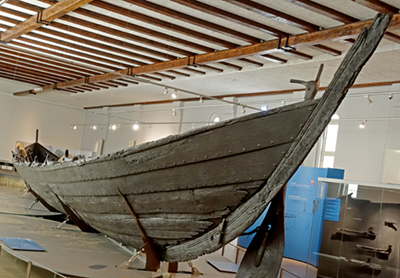
Note that carinated means keel shaped, as when a clinker-built boat is turned upside down, in modern boats looking from the bow to the stern, though the same shape is evident in the stern of boats from the Viking era.
This photo is of the Nydam boat or Nydam ship ( Danish : Nydambåden ), a rowing boat that was sacrificed around 340 AD in the Nydam Moor ( Sønderjylland ) and was discovered and excavated in 1863. It was an ocean-going war vehicle that was a fast troop transport that could carry up to 45 men. The Nydam boat is exhibited in the Nydam Hall of the Archaeological State Museum in Gottorf Castle in Schleswig.
Photo: Don Hitchcock 2018
Text: Don Hitchcock, and Wikipedia
Source: Museum für Archäologie Schloss Gottorf
Figure 12 - Abri du Renne: A selection of base/bottom outlines of nosed grattoirs.
A very high proportion of nosed tools (fig. 12). The abundance of this type of tool constitutes a very important element of this deposit. (small blocks; small cores; long or roundish flakes): 10 rounded snouts, 40 elongated and almost tapered snouts along the axis of the piece; 5 muzzles/noses tilted to the right, 7 snouts/noses tilted to the left; 4 approaching the shape of a taraud (large awl). These pieces generally have the sides retouched; most are domed, but a few are flat.
Burins: straight bec de flûte, or dihedral burin, (26); burins on blade angles (10, where the retouched oblique shape dominates); chisels-on flake angles (24, same observation; note a thick flake ending with a strong chisel released by means of two very marked notches); hooked chisels (8, the hooked side is always on the left; and the right side is vertical or slightly oblique). We will note the presence of this type of burins as a character of this deposit. — Scraper chisels: 3, two of which are of good quality.
Perçoirs and tarauds:
(
a perçoir is a small drill or awl, a taraud is a large awl or pointed digging tool, often used for wood, and often of rough workmanship - Don )
12 fairly characterised pieces; none is remarkably fine. Triangular flakes, reminiscent of those which provide the Mousterian 'point' (14 clear specimens); used edges; retouched edges; chipped tips. Let us note a piece having the entire left edge retouched above, the half-length of the right edge retouched below, so that these reverse retouches meet at the top of the tool.
Saws (24), visibly used: straight or arcuate cutting edge, sometimes showing teeth resulting from use; several are rectangular flakes with thick backs.
Scrapers (30),- almost always longer than wide; some recall Mousterian retouching; the working side is either convex or rectilinear (a case with a sinuous edge); a double scraper; complex shapes (eg: ending, with a nose next to a notch; — heel arranged in the shape of a scraper).
Totals of the main pieces of lithic tools:
Grattoirs 184 (including 29 on blades, 25 on long flakes, 29 short flakes, 7 rounded, 15 concave, 13 carinated, 66 with noses)
burins 58, (including 26 ordinary, 24 angled, 8 parrot's beak),
burins-grattoirs 3, racloirs 27, rabots 8, retouched blades 22, knives 48, saws 26; — perçoirs or drills 12; — triangular pieces 14; — pics 2.
The deposits of Belcayre-Bas, from the flooded deposit under the
Belcayre castle, up to 150 metres beyond La Métairie, are all
Palaeolithic. They provide information on the tools of an
evolved Mousterian, from the Middle Aurignacian (phases I and III, it seems) and the early Magdalenian (phase II or III). Particularly the last deposit, if it could have been excavated correctly, would have provided important documentation for the morphology of lithic material. We will remember among the interesting elements the engraved slab, a good example of Aurignacian art.
These deposits having not shown any Solutrean level, we will also note the superposition of the ancient Magdalenian on the Aurignacian with a fairly weak separation, and the presence of anneaux and cupules.
References
- Bourrillon R., White R., 2015: Early Aurignacian Graphic Arts in the Vézère Valley: In Search of an Identity?, in White R., Bourrillon R. (eds.) with the collaboration of Bon F., Aurignacian Genius: Art, Technology and Society of the First Modern Humans in Europe, Proceedings of the International Symposium, April 08-10 2013, New York University, P@lethnology, 7, 118-137.
- Burkitt M., 1925: Prehistory: a study of early cultures in Europe and the Mediterranean basin, Cambridge, Cambridge University Press. 1925, Second Edition.
- Cheynier, A., 1963:Les burins, Bulletin de la Société préhistorique de France, tome 60, n°11-12, 1963. pp. 791-803; doi : https://doi.org/10.3406/bspf.1963.3956 https://www.persee.fr/doc/bspf_0249-7638_1963_num_60_11_3956
- Delage, F., 1949: Les gisements préhistoriques de Belcayre (Dordogne), Gallia, tome 7, fascicule 1, 1949. pp. 3-21; doi : https://doi.org/10.3406/galia.1949.2115 https://www.persee.fr/doc/galia_0016-4119_1949_num_7_1_2115
- Howell, F., 1965: Early man, Life Nature Library. Time, Inc. New York 1965
- Movius H.L. Jr, David N., Bricker H., Clay B., 1968: The analysis of certain major classes of upper palaeolithic tools: Stratigraphy, American School of Prehistoric Research, Peabody Museum, Harvard University, Cambridge, Massachusetts
